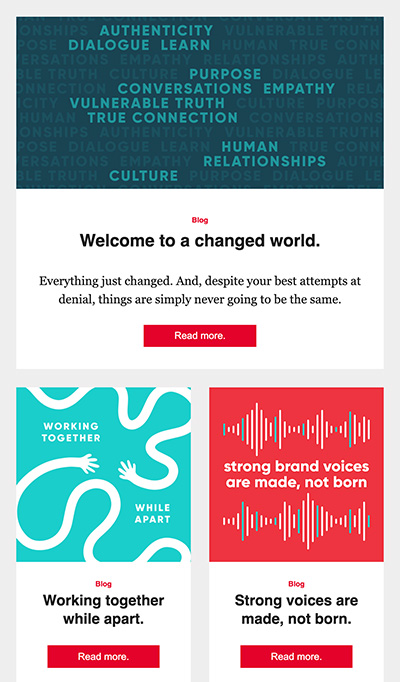When internal thinking drives external communications.
Five major symptoms to gauge if your internal thinking is negatively impacting your external communications.

It’s a common problem.
A company that has been around for decades inevitably creates sophisticated internal processes. Has an increased number of internal meetings. Has more and more layers of internal review. What used to be simple tasks become individuals. And then entire departments. Time moves faster. What used to get solved through customer contact now takes place in conference calls, cross country flights, and the simple need to get things done. People get caught up in their own worlds, their own quotas, their own needs. Mistakes in the past have led to increased internal scrutiny and decreased risk taking.
This necessary and natural process affects all of your external communications. Your marketing efforts may have become infected with this internal thinking, and you may not even realize it. Here are five major symptoms to gauge whether this has happened to you:
1. Your communications are more feature driven than benefit driven.
It’s simple. Features are about you. Benefits are about your audience. Most communications are mistakenly feature driven. Unfortunately, on one cares how the toaster makes toast. They want toast.
2. Your campaigns feel the need to include the kitchen sink.
There are so many ads with so much copy and so many potential customers with so little time. But internally-influenced copy feels the need to include all the facets of everything that we all collectively deemed important. But your customers will care about one thing said well, not a dozen things said haphazardly.
3. What used to be conversational “ad-speak” has been replaced by technical “attorney speak”.
I can spot when copy has been either scrubbed or influenced by attorneys a mile away. They make no claims whatsoever – not even mild ones. They are long-winded, mostly with clarifications. And they deliver emotion about as well effectively as a politician on the campaign trail.
4. You have more than two layers of brand you feel the need to promote.
Brand within a brand within a brand. The classic internally focused issue. Brand the company. Brand the division. Brand the product. Brand the technology. Brand the process. Make nothing connect and nothing sticky, but make all departments feel represented. The most interesting part to me is that these companies can’t even tell you what all this stuff is. “What do we call that technology again?” And you want your customer to give a rat’s hiney?
5. There is not a single engaging reason for being.
More than anything, this is the issue. No one wants to let go of their message. Sales wants an immediate price/value message. Engineering wants a feature message. Marketing wants a new message altogether. Executives want a “see all we’re doing” message. HR wants a “this is a great place to work” message. By even trying to balance all of these messages, you’re missing it. Your customers don’t care about any of the above.
The cure? It’s simple, but can be difficult. It’s about listening to the needs – the true needs – of your customers. Not just that one big customer, but all of them. Understand from their point of view what makes you different/special/meaningful. Then build on it in a simple, concise way over and over. The brands that are commonly known universally as the ones who “get it” have always understood this. But it must always be seen through the eyes of your customer. Always.


